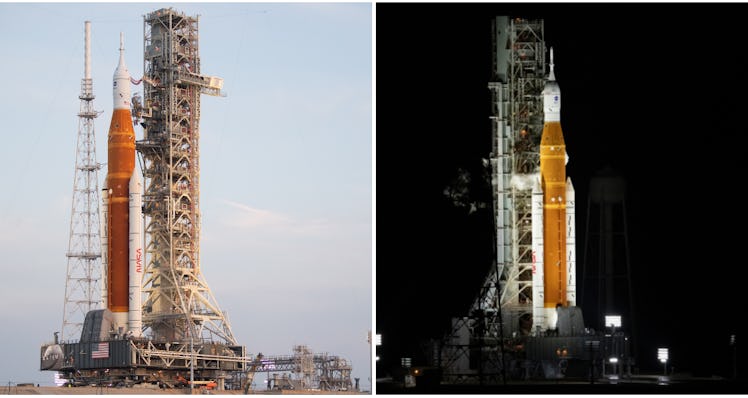Meet Artemis 1, The Next Gen Rocket That Might Head To The Moon This Friday
Mission Artemis involves several key steps that will, hopefully, set the stage for more space travel.

NASA is gearing up for an exciting mission we’ve not seen in 50 years. A next-generation spacecraft is preparing for a journey to the Moon, the first step in several planned tasks to get American astronauts back to the Moon’s surface.
But what is Artemis, really? When will it take off, now that the initial launch plans were scrubbed? Why were the launch plans scrubbed? And what will the rocket do when it’s in space? Here’s what you need to know, after August 29’s planned launch was called off.
What Is The Artemis Mission?
Artemis is the name given to the mission that will set the course for returning to the Moon. “With Artemis missions, NASA will land the first woman and first person of color on the Moon, using innovative technologies to explore more of the lunar surface than ever before,” NASA explains.
“We will collaborate with our commercial and international partners to establish the first long-term human-robotic presence on and around the Moon. Then, we will use what we learn on and at the Moon to take the next giant leap: sending the first astronauts to Mars.”
The first step in the mission, called Artemis I, is an uncrewed mission — literally, the space craft is filled with dummies — that will include a Space Launch System Rocket (SLS) and Orion, the name of the spacecraft that will leave Earth’s atmosphere. The goal of the first step is to ensure the technology works before sending people up with it.
Artemis II will send astronauts to lunar orbit and back to Earth. The final mission, Artemis III, will have the astronauts land on the Moon’s surface.
The goal is first to learn more about the Moon, including any potential water sources, and “learn how to live and operate on the surface of another celestial body.”
The ultimate goal of Artemis is to learn enough from the time on the Moon to eventually visit Mars, which is estimated to be a three year roundtrip journey, according to NASA.
Why Was The August 29 Launch Called Off?
In the morning hours on August 29, the first step in a multi-year plan to return astronauts to the Moon was called off. The uncrewed spaceship was set to liftoff between 8:33 a.m. and 10:33 a.m. local time from NASA’s Kennedy Space Center in Florida, The New York Times reports.
The event was going to be live-streamed by NASA on its YouTube channel. However, the launch was called off. At first, the Artemis I mission was only going to be postponed for an hour while engineers investigated a potential issue with one of the four core-stage engines. But just after 8:40 a.m., the launch was officially called off for the day.
Why? NASA tweeted: “The launch of #Artemis I is no longer happening today as teams work through an issue with an engine bleed. Teams will continue to gather data, and we will keep you posted on the timing of the next launch attempt.”
When Might NASA Attempt An Artemis 1 Launch Next?
When the initial launch date was canceled, there wasn’t an official new date scheduled as the engineers worked to solve the issue with the engine.
However, according to CNN, the next possible time the launch could be rescheduled would be Friday, September 2 at 12:48 p.m. ET. But that depends on how testing goes today on the issue that delayed the launch in the first place...so check back here for updates.
For more details on the launch of mission Artemis I and how to watch live when it does lift off, check out NASA’s live coverage website.
This is a developing story. Check back here for updates.